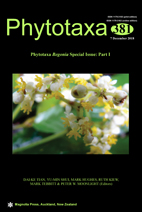Abstract
The rDNA sites are useful chromosome landmarks and can provide valuable information for species identification and species relationships. In this study, we investigated the distribution of 5S and 45S rDNA sites in 29 species of Begonia sect. Coelocentrum Irmsch. using a two-colour fluorescence in situ hybridization (FISH) technique. This is the first report of chromosomal rDNA mapping in Begonia species. The analyzed species showed considerable diversity in rDNA distribution patterns. The 45S rDNA signals are always located in terminal regions on 1−4 chromosomes, while 5S rDNA signals are mainly located at proximal regions on 2−8 chromosomes, varying from specific major signals to highly dispersed minor signals. Based on rDNA FISH patterns, most of the investigated species could be distinguished from each other and species relationships were identified. In addition, the results provided clear proof that B. huangii is of hybrid origin and the triploid B. longgangensis was allotriploid rather than autotriploid as suggested before. The data will provide a useful reference for evaluation, conservation and utilization of the natural resources of the mega-diverse genus Begonia.

